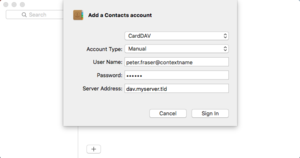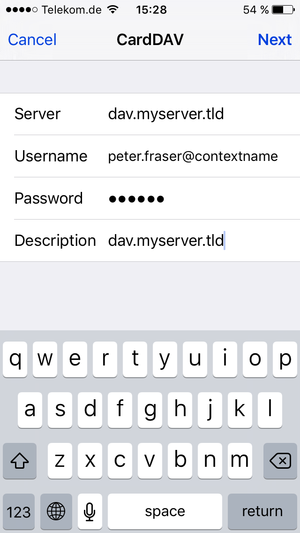AppSuite:CardDAVClients: Difference between revisions
No edit summary |
No edit summary |
||
| (5 intermediate revisions by 3 users not shown) | |||
| Line 1: | Line 1: | ||
= Open-Xchange Contacts synchronization with CardDAV = | = Open-Xchange Contacts synchronization with CardDAV = | ||
This article is valid until the version 7.8.4 of the Open Xchange Server. | |||
For newer versions, please visit https://documentation.open-xchange.com . | |||
This site describes how the Open-Xchange server can be accessed via its CardDAV interface after the server has been configured as described in [[Caldav_carddav_Bundles]]. Depending on the used client software, different steps are necessary. Other clients may be configured similarly, but are not officially supported. | This site describes how the Open-Xchange server can be accessed via its CardDAV interface after the server has been configured as described in [[Caldav_carddav_Bundles]]. Depending on the used client software, different steps are necessary. Other clients may be configured similarly, but are not officially supported. | ||
| Line 7: | Line 10: | ||
Depending on the used Mac OS X version, slightly different steps are necessary. | Depending on the used Mac OS X version, slightly different steps are necessary. | ||
=== | === Mac OS X Contacts === | ||
{| | {| | ||
| [[image:carddav-account5.png|thumb]] || style="width:85%" | | | [[image:carddav-account5.png|thumb]] || style="width:85%" | | ||
* | * Choose "Contacts" -> "Add Account..." from the Contacts App main Menu | ||
* In the "Account | * In the "Choose Contacts Account Provider..." Menu choose "Other Contacts Account..." | ||
* In the "Add a Contacts Account" Menu choose "CardDAV" and "Account Type" "Manual" | |||
* In the "User name" field enter your username | * In the "User name" field enter your username | ||
* In the "Password" field enter your password | * In the "Password" field enter your password | ||
* In the "Server address" field enter your server address '''with the prefix "dav." (e.g. "dav. | * In the "Server address" field enter your server address '''with the prefix "dav." (e.g. "dav.myserver.tld")'''. | ||
* Click " | * Click "Sign In" | ||
|} | |} | ||
| Line 65: | Line 58: | ||
[[Category: AppSuite]] | [[Category: AppSuite]] | ||
[[Category: | [[Category: User]] | ||
[[Category: Clients]] | [[Category: Clients]] | ||
Latest revision as of 08:50, 15 February 2023
Open-Xchange Contacts synchronization with CardDAV
This article is valid until the version 7.8.4 of the Open Xchange Server. For newer versions, please visit https://documentation.open-xchange.com .
This site describes how the Open-Xchange server can be accessed via its CardDAV interface after the server has been configured as described in Caldav_carddav_Bundles. Depending on the used client software, different steps are necessary. Other clients may be configured similarly, but are not officially supported.
Mac OS X Address Book / Contacts
Depending on the used Mac OS X version, slightly different steps are necessary.
Mac OS X Contacts
|
PLEASE NOTE: For our product Open-Xchange Server Edition for UCS it isn't necessary to use "dav".
Debug Options
You can enable a Debug Menu inside the Address Book application which gives you access to advanced debugging and logging options. Please notice that some of these options may increase the size of the log files of your system and/or could also log sensitive data like passwords if enabled. Keep also in mind that any setting changed here will remain active until the setting itself will be reverted or changed again which means that disabling the Debug Menu itself is not sufficient to reset any debug settings to their defaults. All settings are case sensitive.
Open a terminal window (Applications > Utilities > Terminal) and issue the following command for
- enabling the Debug Menu in the AddressBook:
defaults write com.apple.AddressBook ABShowDebugMenu -bool true
- disabling the Debug Menu in the AddressBook:
defaults write com.apple.AddressBook ABShowDebugMenu -bool false
PLEASE NOTE:: The debug menu is not available in Mac OS X 10.8.
iOS Contacts
The iOS Contacts application on the iPhone, iPod or iPad can be configured as follows.
|
PLEASE NOTE: For our product Open-Xchange Server Edition for UCS it isn't necessary to use "dav".
General Limitations
Please consider the following known limitations for the CardDAV interface:
Unsupported Properties
- Importing or exporting file attachments (property "ATTACH") is not supported via the CardDAV interface.

